Headline-grabbing attacks, such as the Colonial Pipeline hack that shut down a major US pipeline for over a week, demonstrate the potential for cyber incidents to cause significant disruption. In 2020, in the US alone, organizations paid an estimated $350 million for ransomware attacks. For each major breach, hundreds of attacks devastate smaller businesses and their customers.
Firewalls and anti-malware programs alone are not enough to protect an entire network from an attack. A well-rounded security strategy should also include an intrusion detection system (IDS) that pinpoints suspicious traffic once it passes the firewall and enters the network.
This article is an introduction to intrusion detection systems and the role IDSes play in network security. Read on to learn how these systems work and why they are vital in preventing costly downtime and data breaches.
Learn how you can deploy a multi-layered protection for your sensitive data. Discover Data Security Cloud.
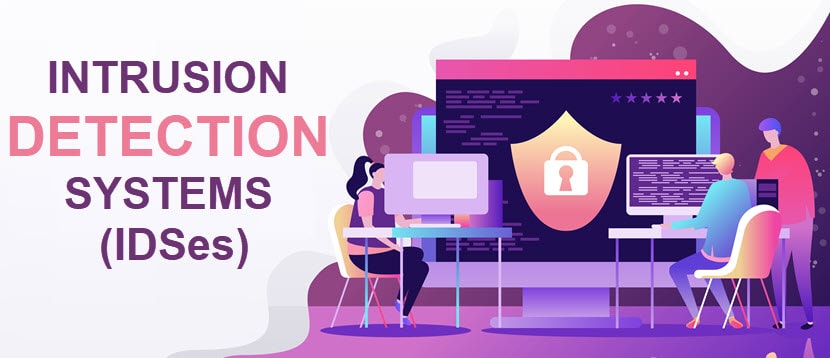
What Is an Intrusion Detection System (IDS)?
An intrusion detection system (IDS) is a software application or device that monitors inbound and outbound network traffic, continuously analyzing activity for changes in patterns, and alerts an administrator when it detects unusual behavior. An administrator then reviews alarms and takes actions to remove the threat.
For example, an IDS might inspect the data carried by network traffic to see if it contains known malware or other malicious content. If it detects this type of threat, it sends an alert to your security team so they can investigate and remediate it. Once your team receives the alert, they must act quickly to prevent an attack from taking over the system.
To ensure that an IDS doesn’t slow down network performance, these solutions often use a switched port analyzer (SPAN) or test-access port (TAP) to analyze a copy of the inline data traffic. However, they don’t block threats once they enter the network, unlike intrusion prevention systems.
Regardless of whether you set up a physical device or an IDS program, the system can:
- Recognize attack patterns within network packets.
- Identify abnormal traffic activity.
- Monitor user behavior.
- Ensure that user and system activity complies with security policies.
The info from an intrusion detection system can also help the security team to:
- Audit the network for vulnerabilities and poor configurations.
- Create more effective controls and incident responses.
- Assess the integrity of critical systems and files.
- Analyze the quantity and types of cyber threats attacking the network.
Cybersecurity benefits aside, an IDS also helps achieve regulatory compliance. Greater network visibility and better logging ensure network operations stay in line with all relevant regulations.
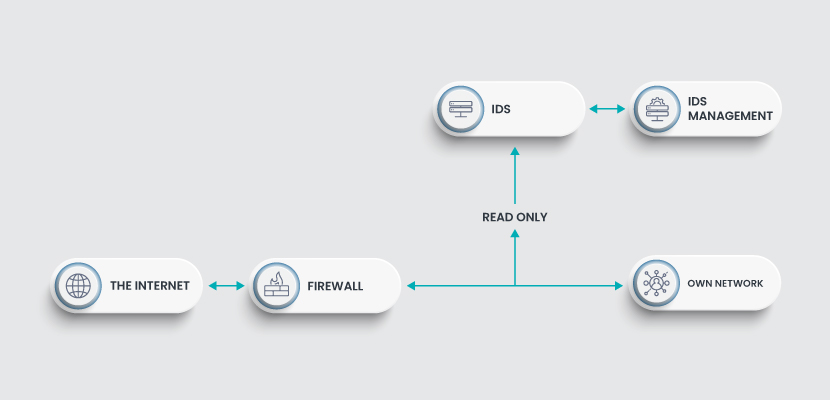
Our article on types of network security explains what other measures besides IDSes companies can deploy to keep intruders away from valuable data and resources.
Goals of Intrusion Detection Systems
A firewall alone doesn’t provide adequate protection against modern cyber threats. Malware and other malicious content are often delivered using legitimate types of traffic, such as email or web traffic. An IDS provides the ability to inspect the contents of these communications and identify any malware that they might contain.
The primary objective of an IDS is to identify anomalies before hackers achieve their goal. Once the system detects a threat, the IDS informs the IT staff and provides the following information about the danger:
- The type of threat.
- The source address of the intrusion.
- Target and victim addresses.
The secondary goal of an intrusion detection system is to observe intruders and identify:
- What types of cyber attacks intruders initiate.
- What resources attackers try to access.
- How hackers try to bypass security controls.
The company’s security operations center (SOC) and analysts can use this info to improve the network security strategy.
Anomaly detection and reporting are the two primary functions of an intrusion detection system. However, some detection systems can respond to malicious activity, such as automatically blocking an IP address or shutting down access to sensitive files. Systems with these response capabilities are intrusion prevention systems (IPSs).
How Do Intrusion Detection Systems Work?
An IDS monitors traffic to and from all devices on a network. The system operates behind a firewall as a secondary filter for malicious packets and primarily looks for two suspicious clues:
- Signatures of known attacks.
- Deviations from regular activity.
An intrusion detection system typically relies on pattern correlation to identify threats. This method enables an IDS to compare network packets against a database containing signatures of known cyber attacks. The most common attacks an IDS can flag with pattern correlation are:
- Malware (worms, ransomware, trojans, viruses, bots, etc.).
- Scanning attacks that send packets to the network to gather info about open or closed ports, types of permitted traffic, active hosts, and software versions.
- Buffer overflow attacks that replace database content with malicious executable files.
- Asymmetric routing that sends a malicious packet and bypasses security controls with different entry and exit routes.
- Protocol-specific attacks that target a specific protocol (ICMP, TCP, ARP, etc.).
- Traffic flooding breaches that overload the network, such as a DDoS attack.
Once an IDS discovers an anomaly, the system flags the issue and raises the alarm. The alert can range from a simple note in an audit log to an urgent message to an IT admin. The team then troubleshoots the problem and identifies the root cause of the issue.
What Are the Types of Intrusion Detection Systems?
There are two main types of IDSes based on where the security team sets them up:
- Network intrusion detection system (NIDS).
- Host intrusion detection system (HIDS).
The way an intrusion detection system detects suspicious activity also allows us to define two categories:
- A signature-based intrusion detection system (SIDS).
- An anomaly-based intrusion detection system (AIDS).
Depending on your use case and budget, you can deploy a NIDS, an HIDS, or rely on both main IDS types. The same applies to detection models, as many teams set up a hybrid system with SIDS and AIDS capabilities.
Before determining a strategy, it's essential to understand the differences between IDS types and how they complement each other. Let us look at each of the four main IDS types, their pros and cons, and when to use them.
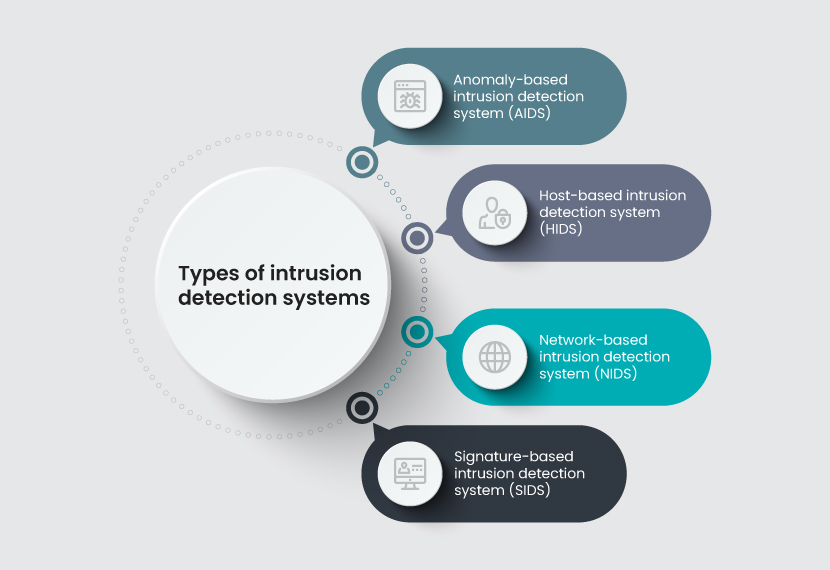
Network Intrusion Detection System (NIDS)
A network-based intrusion detection system monitors and analyzes traffic coming to and from all network devices. A NIDS operates from a strategic point (or points, if you deploy multiple detection systems) within the network, typically at data chokepoints.
Pros of a NIDS:
- Provides IDS security across the entire network.
- Relatively easy to secure and hide from intruders.
- A passive device that does not compromise network availability or throughput.
- A few strategically placed NIDSes can monitor an enterprise-sized network.
- Covers network parts where traffic is most vulnerable.
Cons of a NIDS:
- Expensive to set up.
- Detecting threats within encrypted traffic can be problematic.
- If a NIDS must monitor an extensive or busy network, the system can suffer from low specificity and an occasional unnoticed breach.
- It is typically not an ideal fit with switch-based networks.
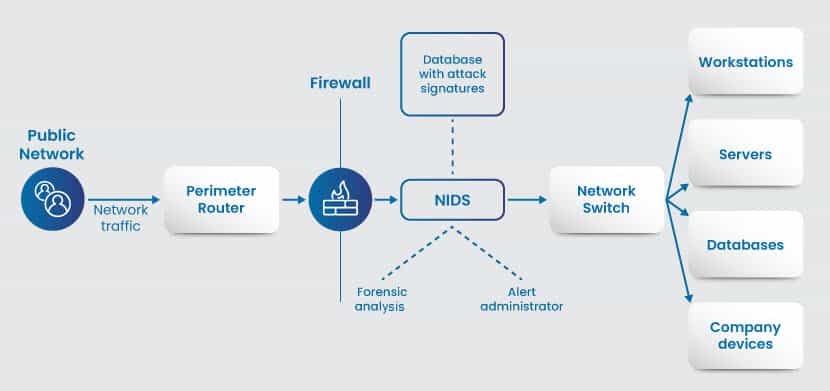
Host Intrusion Detection System (HIDS)
A HIDS operates from a specific endpoint, monitoring network traffic and system logs to and from a single device.
This type of IDS security relies on regular snapshots, file sets that capture the entire system’s state. When the system takes a snapshot, the IDS compares it with the previous state and checks for missing or altered files or settings.
Pros of a HIDS
- An excellent second line of defense against a malicious packet that a NIDS failed to detect.
- Offers deep visibility into the host device and its activity (changes to the configuration, permissions, files, registry, etc.).
- Effective at detecting packets originating from within the organization, such as unauthorized file modifications from a system console.
- Effective at detecting and preventing software integrity breaches.
- Better at analyzing encrypted traffic than a NIDS due to fewer packets.
- Far cheaper than setting up a NIDS.
Cons of a HIDS
- Limited visibility as the system only monitors one device.
- Less available context for decision-making.
- More visible to attackers than a NIDS.
- Hard to manage for large companies as the team needs to configure and handle info for every host.
- Not good at detecting network scans or other network-wide surveillance attacks.
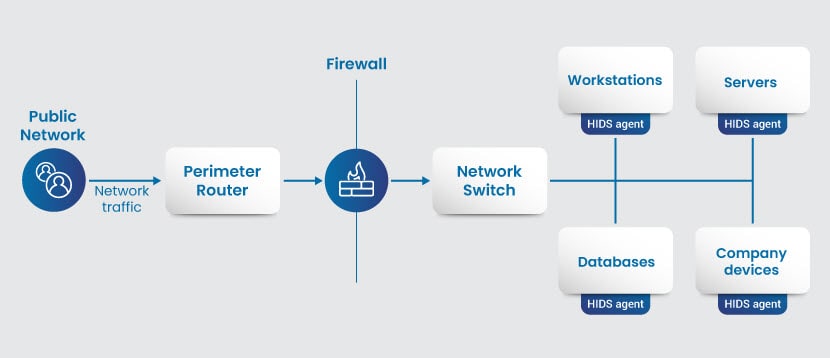
Signature-Based Intrusion Detection System (SIDS)
A SIDS monitors packets moving through a network and compares them to a database of known attack signatures or attributes. This common type of IDS security looks for specific patterns, such as byte or instruction sequences.
Pros of a SIDS
- Works well against attackers using known attack signatures.
- Effective at monitoring inbound network traffic.
- Helpful for discovering low-skill attack attempts.
- Can efficiently process a high volume of network traffic.
Cons of a SIDS
- Cannot identify a breach without a specific signature in the threat database.
- Regular updates of the threat database are required to keep the system up to date with the latest risks.
- A savvy hacker can modify an attack to avoid matching known signatures, such as changing lowercase to uppercase letters or converting a symbol to its character code.
Anomaly-Based Intrusion Detection System (AIDS)
An AIDS monitor continuously monitors network traffic and analyzes patterns against a baseline. It goes beyond the attack signature model and detects malicious behavior patterns instead of specific data patterns.
This type of IDS uses machine learning to establish a baseline of expected system behavior (trust model) in terms of bandwidth, protocols, ports, and device usage. The system can then compare any new behavior to verified trust models and discover unknown attacks that a signature-based IDS cannot identify.
For instance, when someone in the Sales department first tries to access the website’s backend, it may not raise a red flag for a SIDS. For an anomaly-based setup, however, a person trying to access a sensitive system for the first time is a cause for investigation.
Pros of an AIDS
- Can detect signs of unknown attack types and novel threats.
- Relies on machine learning and AI to establish a model of trustworthy behavior.
Cons of an AIDS
- Complex to manage.
- Requires more processing resources than a signature-based IDS.
- High amounts of alarms can overwhelm admins.
Our article about the best network security tools presents the top options on the market and helps create the perfect security tool stack.
IDS Strengths and Limitations
The obvious strength of deploying an IDS is the critical insight into network activity. The early detection of unusual behavior helps minimize the risk of cyber attacks and ensure better network health overall.
Using an IDS to protect a network is a valid strategy to boost security. When paired with a robust anti-malware program and firewall, an IDS ensures the team:
- Stays ahead of a large percentage of cyber problems, whether caused by a malicious actor, accident, or error.
- No need to sift through thousands of system logs for critical information.
- Can reliably enforce the company’s security policies at the network level.
IDSes (and even IPSes) are becoming cheaper and easier to administer, allowing even SMBs with smaller budgets and fewer IT staff to rely on this strategy. Despite all the benefits, however, IDSes also have some unique challenges:
- Avoiding an IDS is the priority for a successful attack, making these systems the go-to target for hackers.
- An IDS can be less effective in a network with high amounts of traffic.
- Detecting malicious activity within encrypted traffic is a common issue.
- Even the best system can have problems recognizing signs of a novel attack.
- IDS monitors north-south traffic, it does not provide insight into east-west traffic.
The biggest challenge of an IDS is avoiding mistakes, as even the best system can:
- Raise the alarm for something that is not an attack (a false positive).
- Fail to raise the alarm when there is a real threat (a false negative).
Too many false positives mean the IT team will be less confident of the IDS’s warnings. False negatives, however, mean that malicious packets are entering the network without raising an alarm, so an oversensitive IDS is always a better option.
Managed detection response (MDR) is a hands-off alternative to an in-house IDS as you can rely on a vendor to protect your network devices and data.
IDS Best Practices
Once you know what IDS type and detection model you need to set up, ensure your strategy follows these best practices:
- Train IT staff. Ensure the team setting up the IDS has a thorough understanding of your device inventory and each machine’s role.
- IDS deployment. Deploy the IDS at the highest point of visibility to avoid overwhelming the system with data. Ideally, place the IDS at the edge of your network, behind the firewall. Install multiple IDSes across the network if you need to deal with intra-host traffic. The right choice of system and deployment location depends on the network and security goals.
- Determine a baseline. To ensure your IDS can distinguish between normal and abnormal behaviors, establish a baseline to understand what’s on your network. Keep in mind that each network differs in the type of traffic it carries. Defining a clear initial baseline helps prevent false positives and false negatives.
- Tune the IDS to the network. Change the default settings of the IDS only where it makes sense for the network. Configure the IDS to accommodate all devices, applications, ports, protocols, and security points on the network. By customizing the configuration to apply to your network infrastructure, you create a solid base for detection.
- Set up stealth mode. Set the IDS to run in stealth mode, making the system harder to detect for malicious actors. The simplest way to do so is to ensure the IDS has two network interfaces, one for the network and the other for generating alerts. The IDS should use the monitored interface as input only.
- Balance false positives and negatives. Be careful not to over-tune your IDS or misconfigure it, as this can lead to false positives or negatives. Too many of either can overwhelm your IT and security teams, putting your organization at greater risk of an attack. Combine NIDS setups and network segmentation to enhance detection effectiveness and simplify management.
- Test the IDS. Test the IDS to ensure it detects potential threats and responds to them properly. Use test datasets or, even better, have security professionals do a penetration test (pen test). Run these tests regularly to make sure everything continues to work as expected. Over time, adapt your testing approach to keep pace with evolving types of attacks.
- Update the threat database regularly. Once the IDS is operational, your team should regularly update the threat database to maintain the system's effectiveness. Ensure all your IDSes and threat databases follow the principle of zero-trust security.
- Investigate and respond to incidents. Develop an incident response plan that is ready to be implemented. This plan must include skilled security personnel who can respond quickly and effectively, minimizing disruption to daily operations and impact on your organization. If your organization must comply with certain industry requirements, such as HIPAA, GDPR, or SOC 2, define proper controls in place and follow established protocols. Consider adding a secondary analysis platform to analyze threats after the IDS raises the alarm.
Read about SecOps, a strategy that ensures security team and IT operations do not work in silos and enforces security best practices across the development process.
Do Not Overlook the Value of IDS Security
A reliable IDS or IPS is essential for network security, but it should be part of a broader security strategy. It's also important to educate employees on protecting the organization, information, and assets. The initiative should begin with an effective cybersecurity awareness program. In return, employees will have greater confidence in knowing how to minimize risks to your business and your customers.
Protect your critical assets with VMware-powered Data Security Cloud. Leverage its integrations with cutting-edge security technologies to ensure maximum protection for your critical assets. See pricing plans.
This article was written with the help of Eyal Katz, head of mvpGrow and a cybersecurity marketing expert.




